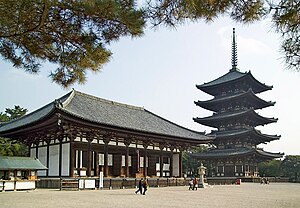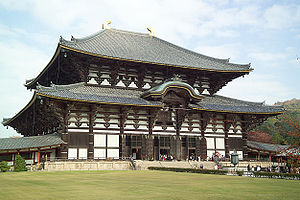 | ||
| Nara | ||
| prefecture | Nara | |
|---|---|---|
| Residents | 352.377 (2021) | |
| no tourist info on Wikidata: | ||
| location | ||
| ||
Nara (奈良 市 Nara-shi) is the capital of the prefecture of the same name Nara in the south of the main Japanese island Honshu.
background
Nara was from 710 to 784 under the name Heijō-kyō (平城 京) the capital of Japan. Most of the temples and shrines were founded during this time. After that it was Kyoto declared the capital. Due to the loss of worldly power, Nara was able to develop into a religious center. Today Nara is also an important university town. The road network is built like a chessboard based on the Chinese model.
The well-preserved temples and the remains of the imperial palace belong to the city because of their historical significance UNESCO world cultural heritage.
getting there

By plane
By train
Of Kyoto The JR Kansai Line runs to Nara, as does the private Kintesu-Kyoto Line. Of Osaka the Kintesu-Nara Line is the fastest way to get to Nara. Both JR train station 1 Nara station (around 1.5 km) as well as the Endbahnof 2 Kintesu Nara Station (around 1 km) are within walking distance of the most important sights in Nara Park.
By bus
In the street
mobility

The JR station, Nara Station is considered the city's main train station. From here public buses go to all sights.
Tourist Attractions
Most tourists visit Nara as a day trip from Kyoto. However, there is more to see than can be enjoyed in one day. It would be better to plan 2 days, one for the buildings in and around Nara Park, and one day for the rest of the sights.
In Nara there are several buildings included in the list of UNESCO World Heritage Site were recorded. These are: Todai-ji, Kofuku-ji, Kasuga Shrine, Gangō-ji, Yakushi-ji, Toshodai-ji and the remains of the Heijō Palace. The Hōryū-ji is a bit out of the way in the southwestern small town Ikaruga.
Religious buildings

- 1 Kofuku-ji
From the temple complex Kofuku-ji Originally 175 buildings, 12 have been preserved. The remaining buildings fell victim to conflagrations and the like. The temple was originally built in Kyoto, but was moved here in 710. It is the main temple of the Fuijwara family. A three-story (1143) and a five-story pagoda (1426) have been preserved. The five-storey one is only a few centimeters smaller than the To-ji pagoda in Kyoto, making it the second largest in Japan.
- Kokuhokan. The modern concrete building is a national treasury, it shows the statues and works of art rescued from the destroyed buildings. Hours of Operation: 9 am-4.30pm (¥ 500) daily
- 2 Gangō-ji
Three historical sites are well preserved: a five-story mini pagoda, the main hall Gangō-ji Gokurakubō and the zen room.
- 3 Yakushi-ji
Only the eastern pagoda of the temple complex is original, it is 33.6 m high and has 3 floors with intermediate roofs, so that it appears to be six floors. All other large buildings have only been restored in the last few decades.
- 4 Todai-ji
The Great East Temple or Todai-ji is the main shrine of the Buddhist Kengon sect. It was inaugurated in 752. The temple, which is actually a temple district, consists of several buildings, unfortunately not all of them have been preserved. The main axis (south-north) of the temple complex is formed by Nadai-mon, Chu-mon, Daibutsuden and Kodo. To the west of it are Shingon-in, Sashizudo, Shosoin, Kaidan-in, Saidei-mon and Tegai-mon. To the east of it are Tonan-in, the Temple Office, Toto Pagoda, the Chisokuin Hogon-in bell tower, Oyuya, Hashuin Nembutsudo, Sammai-do, Kaisaido, Kannon-in, Wakasai, Sangatsu-do, Nigasu-do and the Tamakayama Hachimangu -Shrine.
 Octagonal lantern in front of Daibutsu-den |  Gatekeeper in the south gate |  The great buddha Daibutsu |  Figure next to the great Buddha |
Some details:
- Nadai-mon. The great South gate, is a two-story structure supported by 18 columns.

- Daibutsuden, the hall of the great Buddha, is only around 2/3 of its original size, and is still considered one of the largest wooden structures in the world. With a length of 57 m, a width of 50.5 m and a height of 48.5 m, one hardly believes that this is a scaled-down replica. Inside is the largest Buddha statue in Japan. The bronze seat statue itself has a height of 16.2 m, it is located on a bronze seat pedestal, which is designed as a 56-petalled lotus flower and has a circumference of 20.7 m.
- Kaidan-in. The temple was founded in 754. The current building had to be rebuilt around 1730. Inside are the statues of Shakymuni and Taho-Nyo-Rai. In the corners are the four sky guardians in full armor.
- in the Bell tower is the second largest bell in Japan (3.9 m high and 2.8 m diameter). It is a new casting from 1239, the first bell was cast in 749 and badly damaged in a typhoon in 989.
- Sangatsu-do, the hall of the third month is the oldest surviving building on the site (not a replica!). It was built by Roben in 733. The Raido prayer hall was added around 1200 during the Kamakura period. Based on the roof art structure, it is easy to distinguish what belongs to which structure.
- Nigasu-do. The Second Month Hall was built in 752 by priest Jichu. It had to be rebuilt after a fire in 1669.
Numerous tame ones are already waiting at the entrance to Todai-ji Sika deer on their feed. You can buy it here for ¥ 150, and - as long as the food lasts - you have been accompanied. Sometimes quite pushy. Please do not feed anything else, it could harm the animals, they also eat paper and packaging.
 The south gate |  Great Buddha Hall |  The bell tower in Todai-ji |
- 5 Kasuga-taisha.
You can get to the Kasuga Shrine through Nara Park, past over 1000 stone lanterns.

- 6 Toshodai-ji
The temple was founded in 759. The lecture hall Kōdō comes from the imperial palace in Nara and is the only well-preserved building of the palace.
Castles, chateaux and palaces
- 7 The remains of the Heijō Palace Heijō-kyō. Most of the buildings have either been moved or have fallen into disrepair over time. In the meantime, the archaeologists have dealt intensively with it, and it is thanks to their work that the remains are part of the world's cultural heritage.
Buildings
Monuments
Museums
- 8 Nara National Museum. In the museum there is a focus on the role of the Buddhism in Japan.
- 9 Neiraku Art Museum. The Neiraku Museum opened in 1969
Streets and squares
Parks

- The Nara Park (Nara-koen) is also known for its tame deer. Please only feed the deer the special food places that are sold in the park.
- 10 Isui-en, the beautiful garden with a carp pond, dates from the Meiji period. It is certainly one of the most beautiful gardens in the city.
- Man'yô (Botanical Garden)
various
- 11 Sarusawa-ike, carp pond with a beautiful view of Kofuku-ji
activities
shop

kitchen
nightlife
accommodation
security
health
Practical advice
trips
literature
Web links
- https://www.city.nara.lg.jp/ (Yes) - Official website of Nara
- Official website (Japanese, English)


